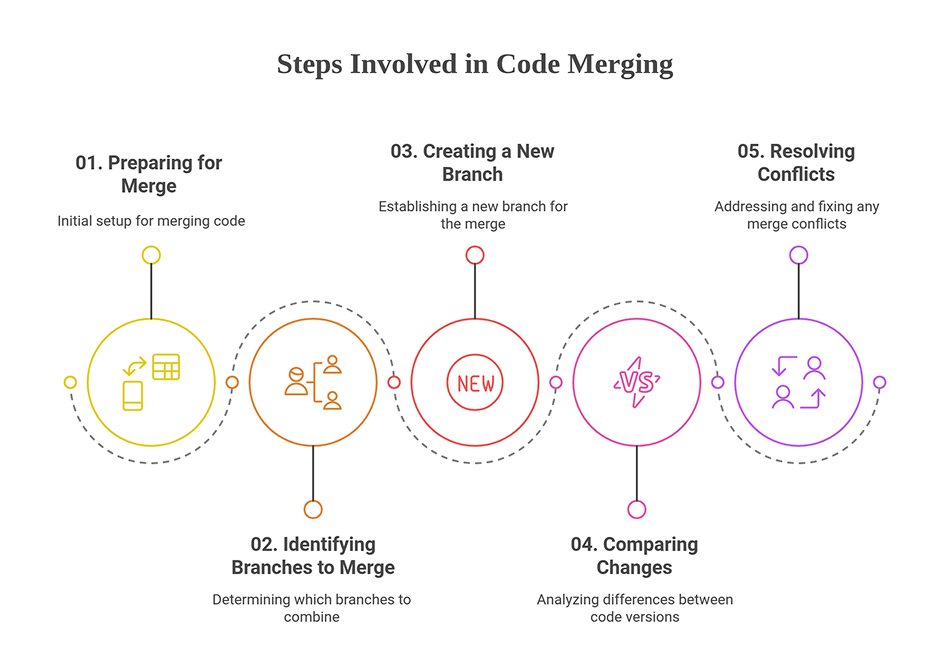Code merging is essential in software development to ensure a unified code base in a collaborative working environment. As development teams grow and projects become more complex, effective code merging becomes crucial for maintaining software quality and productivity.
What Is Code Merging?
Code merging integrates code changes from multiple branches into a single codebase. When developers work on different features in different branches, they need to integrate their changes back into a single codebase. This integration process is known as code merging. It involves comparing several versions of code to produce a coherent version that keeps all intended changes.
Benefits of Code Merging
1. Enhanced Collaboration
- Teams can work simultaneously on different features without interference.
- Changes can be integrated systematically and safely.
- Developers can share and incorporate improvements efficiently.
2. Accelerated Development
- Parallel development of multiple features.
- Reduced waiting time for integration.
- Faster delivery of new features and bug fixes.
3. Quality Assurance
- Controlled integration of changes.
- Opportunity for code review and testing.
- Maintenance of code stability.
How to Merge Code Changes
Before initiating a merge, teams should follow the steps below to ensure a successful code merging process.

1. Preparing for Merge
- Communicate pending changes to affected team members to avoid unnecessary conflicts.
- Review and commit all local changes.
2. Identifying Branches to Merge
- Determine which branches need integration and assess their impact on the main codebase.
3. Creating a New Branch
- Use a dedicated branch to safely perform the merge without affecting the mainline code.
4. Comparing Changes
- Use tools like Git to analyze and compare differences between branches before merging.
5. Resolving Conflicts
- Resolve any conflicts manually or using automated tools to maintain code integrity.
Understanding Code Merging Fundamentals
Definition and Basic Concepts You Must Know
- Base branch: The branch that serves as the foundation for the merge. This is often the main development branch (e.g., main or develop).
- Source branch: The branch containing the changes to be merged.
- Target branch: The branch into which changes are being merged. It is often the same as the base branch, but it could be different in some workflows.
Types of Merges
- Fast-forward merge: Occurs when the target branch has not diverged from the source branch. This allows Git to simply move the branch pointer forward without creating a new merge commit.
- Three-way merge: Used when both branches have changes. This requires Git to create a new merge commit that reconciles differences.
- Squash merge: Combines multiple commits from the source branch into a single commit before merging.
Common Merging Strategies
Feature branch workflow
- Create a branch for each new feature.
- Develop and test independently.
- Merge back to the main branch when complete.
- Suitable for most development teams.
Gitflow workflow
- Maintains separate branches for features, releases, and hotfixes.
- Structured approach to version management.
- Ideal for products with scheduled releases.
- Provides clear separation of concerns.
Trunk-based development
- Developers merge frequently with the main branch.
- Emphasizes small, incremental changes.
- Requires robust testing infrastructure.
- Reduces merge conflicts through frequent integration.
Handling Merge Conflicts
A merge conflict occurs in Git when changes from different branches affect the same file or lines in a way that Git cannot automatically reconcile. In such cases, manual intervention is required to resolve the conflicting changes before completing the merge.
What causes merge conflicts?
- Multiple developers modify the same line of code.
- Long-lived branches diverge significantly.
- Refactoring conflicts with new features.
- Configuration file changes.
Steps to resolve conflicts
- Identify conflicting files using version control tools.
- Manually edit the conflicts or use automated code merge tools.
- Test thoroughly before finalizing the merge.
Tools for conflict resolution
- Git merge and rebase commands.
- Visual merge tools (e.g., Meld, Beyond Compare).
- Integrated development environments (IDEs) with Merge Support.
Prevention strategies
- Frequent integration and rebasing.
- Clear branching strategies.
- Effective communication among team members.
- Make branch protection rules to avoid direct code merge.
Automated Tools and CI/CD Integration
- Continuous integration (CI) practices: Ensure code is merged frequently and tested automatically.
- Automated testing in merge processes: Identifies errors before integration.
- Popular tools: Jenkins, GitHub Actions, GitLab CI/CD, Bitbucket Pipelines.
- Merge checks and gates: Enforce quality standards before merging.
Emerging Trends in Code Merging
AI and advanced collaboration tools are transforming modern code merging, streamlining how teams integrate code.
AI Integration
- AI-powered systems predict merge conflicts by analyzing historical patterns and code changes, enabling proactive conflict prevention.
- Automated tools continuously monitor code quality, detecting potential bugs and security vulnerabilities before deployment.
- AI systems evaluate how merged changes might affect application performance by analyzing code complexity, resource usage, and historical performance metrics.
Collaborative Platforms
- Real-time platforms enable simultaneous code editing with instant conflict detection and resolution.
- Integrated review systems automate code review distribution and policy enforcement.
- Automated documentation tools maintain up-to-date technical documentation as code evolves.
- Built-in communication features facilitate direct developer discussions within the development environment.
Wrapping up
Successful code merging is critical in today’s software development environment. By understanding and using effective merging approaches, teams can improve code quality, streamline communication, and accelerate development. Consistently learning and implementing industry-leading methods and properly using tools and automation will allow teams to successfully manage the complexities of code merging.
